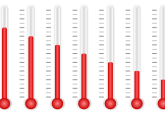Are you really too hot?

As the heat builds into summer and battles for dominion over the office aircon begin to erupt throughout the northern hemisphere, a team of researchers has set out to answer the question: how hot is too hot for humans?
As part of an ongoing research effort by Lewis Halsey (University of Roehampton, UK), the existence of an upper critical temperature (UCT) for human beings has been identified by studying the metabolic rate of study participants at increasing temperatures. This research could have far-reaching implications for sports, working conditions, medicine and travel.
Studies that determine the ideal temperatures for animals to live at are numerous, but, according to Halsey, “weirdly, information is much less available for humans when considering the upper limits of our thermal neutral zone.” The thermal neutral zone describes the range of temperatures at which energy expended by an animal to maintain its core temperature is at a minimum, allowing the animal to maintain its normal basal metabolic rate.
To investigate the impact of heat on the body, the researchers established a cohort of roughly 20 people and monitored each participant’s metabolic rate at room temperature and at subsequent 5oC intervals up to 50oC, simultaneously recording skin and rectal temperature. To measure metabolic rate, the team used an “old but robust” technique known as the Douglas bag. They also monitored heart function using a state-of-the-art echocardiograph to observe how the impact of heat above the UCT impacts the heart for people of varying ages and physical fitness.
 Getting to the root of drought-resistant wheat
Getting to the root of drought-resistant wheat
Scientists have identified genes that affect root length and could make it easier to breed drought-resistant wheat, an ever more important task as global warming starts to take effect.
In an analysis of the literature published last year, Halsey implemented WebPlotDigitizer to reassess some of the key data found, identifying an 11% rise in metabolic rate at 49oC, making a strong case for there being a UTC for humans and for it being close to 50oC. In the current study, the team observed a clear increase in metabolic rate between 40 and 50oC, lending more weight to this conclusion; however, a precise figure will likely be unobtainable due to interpersonal variability which is likely to be considerable for individuals’ UCT.
Speaking to BioTechniques about the results of the heart function experiments, Halsey revealed that, “at rest, in response to being exposed to ambient temperature and humidity of 50oC and 25% respectively for 1 hr, heart rate increased more in women than it did in men and there were also differences between the sexes in terms of changes in the nature of the heart’s ventricle contractions.”
Commenting on the impact of the study, Halsey stated that, “this research provides fundamental knowledge about how we react to suboptimal environments, and how ‘optimal’ differs between people with different characteristics.”

